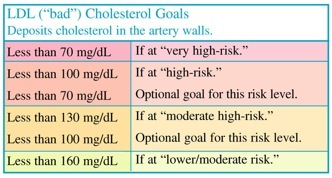-
Staying Well


Ways to Reduce Cholesterol
-
•Take medications, if prescribed.
-
•Limit foods with saturated fats. Strictly limit trans fats. These are hydrogenated oils in foods, such as stick margarine and snack foods.
-
•Use salad dressings and margarines made with plant sterols and stanols (e.g., Benecol and Take Control brands.)
-
•Choose lean beef, pork, lamb, chicken, and turkey. Limit serving sizes.
-
•Eat a variety of fruits and vegetables (5 to 7 or more servings/day) and whole-grain products (6 or more servings/day).
-
•Get 20 to 35 grams of dietary fiber a day.
-
•Eat fish 2 to 3 times a week (especially ones high in omega-3 fatty acids, such as salmon).
-
•Use nonfat and low-fat dairy products.
-
•Limit dietary cholesterol to 300 mg. per day (200 mg. if your cholesterol is elevated).
-
•If you drink alcohol, do so in moderation. (See Use Alcohol Wisely.)
-
•Be physically active. (See Be Physically Active.)
Ways to Reduce Triglycerides
-
•Lose weight if you are overweight. Follow a low-fat diet. Limit alcohol, sugar, and foods with sugar.
-
•Get regular exercise.
-
•Take medications, if prescribed.




Control Your Cholesterol & Triglycerides
Cholesterol is a fat-like substance made in the body (mostly in the liver) and is in animal foods (dietary cholesterol), such as: Organ meats like liver; egg yolks, meats, poultry, and fish; and dairy products with fat. Plant foods have no cholesterol.
{Note: Goals for LDL-cholesterol are based on your risk factors for heart disease. Ask your doctor what your heart disease risk level is.}
Triglycerides are fat-like substances carried through the bloodstream to the tissues which store it for later use as energy. Triglycerides come from the fat in both animal and plant foods.
{Note: High-risk blood cholesterol levels are only one risk factor for heart disease. Learn about other risk factors in Heart Disease.




Get more information, from:
HealthyLearn® | www.HealthyLearn.com. Click on MedlinePlus®.
National Heart, Lung, and Blood Institute | 800.575.9355 (English/Spanish) | www.nhlbi.nih.gov



Copyright © 2009, American Institute for Preventive Medicine. All rights reserved.